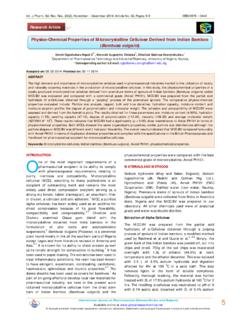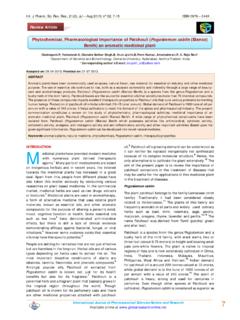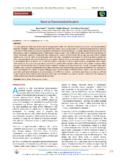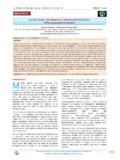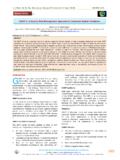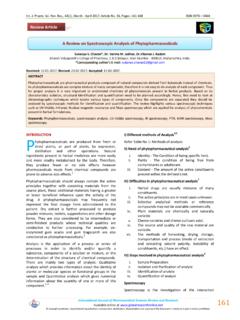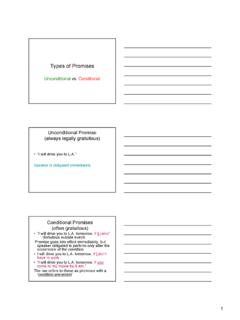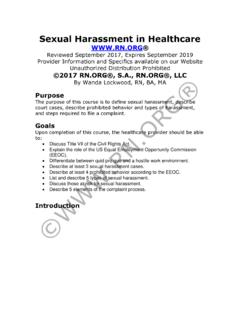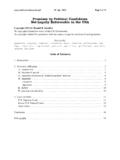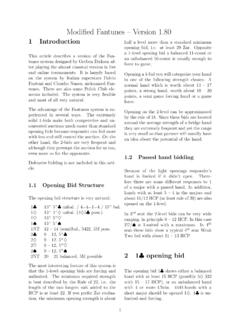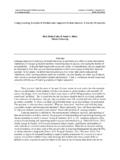Transcription of Review on Immunomodulation and Immunomodulatory …
1 Int. J. Pharm. Sci. Rev. Res., 22(1), Sep Oct 2013; n 41, 223-230 ISSN 0976 044X International Journal of Pharmaceutical Sciences Review and Research Available online at 223 Nagarathna , Reena K2, Sriram Reddy3, Johnson Wesley4 Department of Pharmacology, Karnataka College of Pharmacy, Bangalore, Karnataka, India. *Corresponding author s E-mail: Accepted on: 03-07-2013; Finalized on: 31-08-2013. ABSTRACT The immune system is one of our most complex biological systems in the body. Immunization may be active or passive. The active immunization involves stimulation with an antigen to develop immunological defences against a future exposure and passive immunization involves administration of preformed antibodies to an individual who is already exposed to be exposed to an antigen.
2 Immunomodulatory agents originate from both plant and animal which increases the immune responsiveness of the body against pathogens by activating the non specific immune system. The immune system dysfunction is responsible for various diseases like allergy, asthma, arthritis, cancer and other infectious diseases. So modulation of immune responses too much required to controlling the various infectious diseases. The texts of traditional Indian medicine literature consist of a number of plants reputed to promote physical and mental health, improve defence mechanisms of the body and enhance longevity, lesser number of side effects against synthetic Immunomodulatory agent. Keywords: Immunomodulators, Immune system, Cytokines, T-cells.
3 INTRODUCTION mmune system is a remarkably sophisticated defence system within vertebrates, to protect them from invading agents. It is able to generate varieties of cells and molecules capable of recognizing and eliminating limitless varieties of foreign and undesirable agents. Modulation of the immune system denotes to any change in the immune response that can involve induction, expression, amplification or inhibition of any part or phase of the immune response. Thus, immunomodulator is a substance used for its effect on the immune system. There are generally of two types immunomodulators based on their effects: immunosuppressants and immunostimulators.
4 Immunopharmacology is a comparatively new and developing branch of pharmacology aims at searching for immunomodulators. The potential uses of immunodulators in clinical medicine include the reconstitution of immune deficiency ( the treatment of AIDS) and the suppression of normal or excessive immune function ( the treatment of graft rejection or autoimmune disease). Specific immunomodulators administered together with antigens known as immunological adjuvants to boost the immune response to the vaccine basic function of immune system is to protect against foreign pathogens and infectious agents. This is achieved either through innate or natural immunological mechanisms which essentially serve as a short term first line defence or through elaborate adaptive mechanisms which are highly specific, complex, and marked by diversity and memory.
5 In both types of immunity, cells and molecules play important Immunology is thus probably one of the most rapidly developing areas of biomedical research and has great promises with regard to the prevention and treatment of a wide range of The immune response has two ways of dealing with foreign pathogens. The B-lymphocytes synthesize specific antibodies called immunoglobulins. This is known as humoral immunity. The other system involves T-lymphocytes, which regulate the synthesis of antibodies as well as direct killer cell activity and the inflammatory response of delayed type hypersensitivity. This system is known as cell-mediated Herbs are selected and combined for their ability to inhibit microbial overgrowth in various parts of the body and support those organ systems responsible for immune extracts are potentially curative.
6 Some of these extracts can improve the humoral and cell mediated immunity, against virsuses, bacteria, fungi, For instance, a plant origin saponin used in veterinary medicine whereas, the non-specific immunostimulators offer a generalized state of resistance to pathogens or IMMUNE SYSTEM The immune system is composed of many interdependent cell types that collectively protect the body from bacterial, parasitic, fungal, viral infections and from the growth of tumor cells. Many of these cell types have specialized functions. The cells of the immune system can engulf bacteria, kill parasites or tumour cells, or kill viral-infected cells. Often, these cells depend on the T helper subset for activation signals in the form of secretions formally known as cytokines, lymphokines, or more specifically interleukins.
7 The Innate Immune System Innate immunity comprises a series of host defenses including barrier function, cytokines, complement, phagocytes, natural killer (NK) cells, and gamma-delta (gd) T cells to provide the initial (nonspecific) response to a pathogen or injury. These responses are phylogenetically ancient and have been developed to Review on Immunomodulation and Immunomodulatory Activity of Some Herbal PlantsI Review Article Int. J. Pharm. Sci. Rev. Res., 22(1), Sep Oct 2013; n 41, 223-230 ISSN 0976 044X International Journal of Pharmaceutical Sciences Review and Research Available online at 224 cope with pathogens that are encountered regularly but that rarely cause disease.
8 Unlike the adaptive (specific) immune system, responses are generic and leave no memory; nonetheless the innate immune system functions effectively to keep organisms healthy. Indeed a failing in innate immunity is hypothesized to contribute to secondary infections in critical illness and death in sepsis. Stimulation of the active components of the innate immune system occurs by way of pathogen-associated molecular pattern (PAMP) receptors or damage-associated molecular pattern (DAMP) receptors. PAMPs are recognized by membrane bound or vesicular pathogen recognition receptors (PRRs) including the Toll-like receptors (TLRs), nucleotide binding oligomerization domain (NOD)-like receptors, and RIG-I like receptors.
9 Bacteria stimulate these PRRs to activate various intracellular signalling cascades, leading to a proinflammatory response. For example, the gram-negative bacteria endotoxin, lipopolysaccharide, binds to TLR 4, whereas the gram-positive peptidoglycan binds to TLR 2 In the setting of tissue damage from an infection or trauma, DAMPs activate the innate immune system through these PRRs. Indeed there is significant overlap in mechanisms stimulated by PAMPs and DAMPs. As sedatives are frequently administered during infection and surgery, investigation of their immune effects on these mechanisms of immune stimulation would seem prudent. The Adaptive Immune System Adaptive or acquired immunity differs from the innate response as it is specific, has an element of memory, and is unique to vertebrates.
10 The humoral component involves the proliferation of antigen-stimulated B lymphocytes into antibody-secreting plasma cells. The cellular component is mediated by T lymphocytes, the predominant cell types being helper T cells (Th) and cytotoxic T cells. Recently, regulatory T cells that likely dampen the immune response have been identified. T cells recognize antigens bound to major histocompatibility complex (MHC) proteins by way of T cell receptors that are antigen specific. Th lymphocytes act through secretion of cytokines to elaborate and prime the immune response. This action includes inducing immunoglobin classs witching of B cells, activation of Tc, and optimization of bactericidal capacity of phagocytes.

